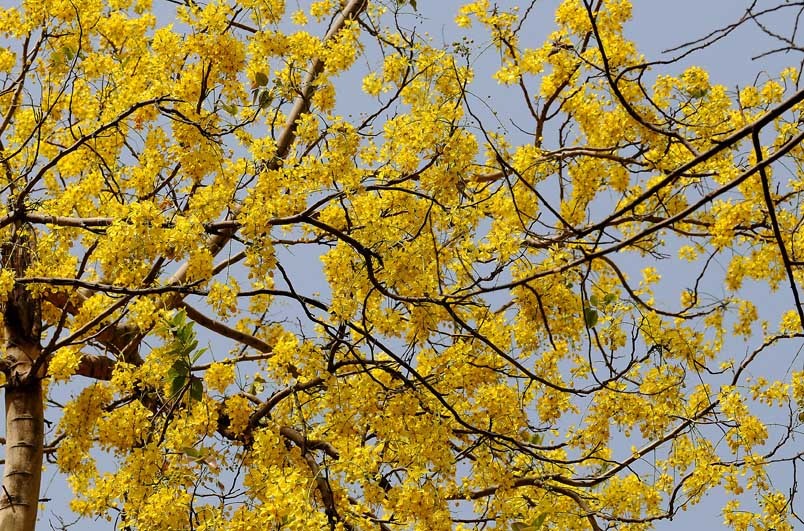
The more the sun beats down, the more these big, bold and beautiful bunch of Amaltas flowers brighten up; seemingly fighting back the scorching heat

Lahore -- sultry, uncomfortable, with its brutal summers -- is also kind in its own way.
Bringing some cheer and respite amidst the dreary heat and humidity, are an array of blooms, bursting with vibrant hues and colours. It is still early in the season but quite a few trees are already dressed in yellow alongside a sleepy stretch of tarmac on the Mall with the scorching summer bringing the glorious Gulmohar and Amaltas to bloom; their beauty almost making the heat bearable. The more the sun beats down, the more these big, bold and beautiful bunch of Amaltas flowers brighten up; seemingly fighting back the scorching heat.
The overnight Cinderella-like transformation of the tree from mundane foliage into a perfect mass of yellow, with flowers and pods more than a foot long, is when Amaltas, the Golden Shower tree, tumbles forth in all its glory.
In the breeze, the flowers seem to dance to a melodious tune with gay abandon, transcending the ordinary, diffusing its magical fragrance around. There are certain pockets in the city where Amaltas have grown to form a delightful canopy on either side of the road, making it seem like a tunnel of welcoming ‘yellow’ flowers, as one passes through.
Amaltas has been around for a long time. Being native to the Indian subcontinent and Southeast Asia, the tree has a mention in ancient scriptures like the Ramayana and the epic Mahabharata, as being found in abundance near Kushika country. However, its influence is not just limited to its medicinal uses or cultural and traditional importance but also extends to the realms of arts and literature. Famous English biologist and botanical artist Marianne North’s (1830-1890) beautiful paintings of the Amaltas tree are still on display at the Royal Botanical Gardens, Kew, England. Similarly, poets have penned romantic verses, and artists have painted the yellow of mustard flowers and the Amaltas trees depicting the festival of Basant.
Although the tree’s yellow flowers herald the season’s brutality, their glittering bloom provides consolation. The branches are sheathed in yellow and the flowers fall all day long, covering the ground in a golden carpet -- yet the trees during its short period of bloom never run short of flowers. The view is so arresting that one wonders how Lahorites are oblivious to the flaming yellows of the Amaltas.
Quite like Lahore’s resilient Amaltas, the Sakura (Cherry Blossom) is Japan’s metaphor for transient perfection. But, unlike Amaltas, their short-lived bloom has woven itself into the country’s imagination as a symbol of hope over the centuries.
‘Hanami’ -- or cherry blossom viewing -- is an important feature of Japanese culture, dating back to the sixth century, and is a unique celebration of nature’s fleeting beauty and a meditation on the passing of time, engaging locals and tourists alike every year.
Yoyogi Park, one of Tokyo’s largest parks with undulating lawns, ponds, and forested areas of cherry blossoms, is abuzz with picnickers during the cherry blossom bloom. Everyone tumbles outside to revel among the flowers. The atmosphere is carnival-esque. An entire city and nation is brought together by the stunning sight of 600-plus cherry trees at different stages of flowering.
The Japanese communities across the world celebrate the Cherry blossom bloom with religious fervour. One is amiss to know why we fail to celebrate the bloom of our local species. The spectacle of trees bedecked with striking yellow flowers providing relief in the scorching summer whilst nature plays out a visual dance of colours is no less than the magnificence of the Cherry Blossom celebration.
The answer to our collective failure to celebrate our indigenous species can be found in the fact that these are the last few remaining amongst the old trees; the rest are gone -- "martyred to make way for urban development," as someone aptly put it once, referring to the trees we lost to the widening of the roads in Lahore. The city continues to grow unplanned and uncontrolled; the native trees like Amaltas are being replaced by fast growing species like rubber plant and conocarpus. Yet, we care less.
In an age where ‘sustainability’ and ‘water budgets’ are the buzz words, we ought to plant native, deciduous trees that have adapted over millions of years of evolution and can survive without any help whatsoever, at home in precisely these conditions.
These native trees work with a very different strategy, and adapt well to the idiosyncratic weather cycle of the city. In water-scarce months, the Amlatas tree ‘shut downs’ for some time, shedding its leaves as it goes into the long dry season. It’s this way these local trees adapt to a dry climate.
Maybe the only way we can start valuing the importance and splendour of these trees could be by stepping out and wandering in gardens and tree-lined boulevards and seeking knowledge about these old, native beings. And, this might become the reason for Lahorites getting deeply in love with the otherworldly Amaltas.
How this tree, in a way, became a cornerstone of Lahore’s cultural history in the past was because the locals took time to admire when it blossomed. We lost the art of admiring our local species somewhere down the line. So, the next time you are walking or merely gazing out of your car window, take a moment and take in the Amaltas bloom. It’s such a feeling that you may even want the dreaded summer to stay for long.